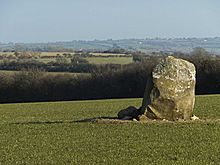|
|
|
|
Cornel BachStanding Stones
|
||||||||||||||||||||||||
|
|
|
Images (click to view fullsize) |
|



|
Fieldnotes |
|
|
Visited 10.10.10 Really easy to access, in a field just off the B4313 running north out of Maenclochog. There is plenty of room to park near by and a handy field gate gives you a fine view of the stones. A short but muddy walk will allow you to get up close and personal. ** If you have recently visited the stones and lost a pair of red frame spectacles I am happy to report they are still there. On a boulder next to the larger of the standing stones. I assume they weren't some sort of 'offering'?! ** Well worth a visit when in this lovely part of Wales. I liked the village a lot also. |
Posted by CARL 15th October 2010ce |
|
Here we are now, right at the foot of Mynydd Preseli. Yet another menhir site near Maenclochog (the village pub, despite being called the Globe Inn, has a painted sign showing a standing stone in a field). The stones lie on an NNE/SSW axis, although they do not seem to be oriented towards each other. The northern stone has four faces, yet feels triangular when viewed from any angle. It's about 5 and a half feet tall, oriented NNW/SSE and, like the other, has some smaller field clearance boulders dumped beside it including a startling great white quartzy one. The south stone lies on a parallel axis, a big fat boulder of a thing. About 80 metres separates them. It has a clear line of sight to the Eithbed burial chambers. visited 18 Aug 04 |
Posted by Merrick 7th September 2004ce |
Miscellaneous |
|
|
Barber & Williams (1989) list it as the remains of a cromlech. They say Samuel Lewis' A Topographical Dictionary of Wales (1844, vol II, p.198) refers to a large stone several tons in weight, so nicely poised on three small upright stones as to vibrate on the slightest touch and upon being struck it sounded like a bell. They go on to say it was blown up with gunpowder by village inhabitants, and that Archaeologia Cambrensis in 1974 list two stones both 6ft high. Clearly, if it was a cromlech then either one of the stones has been moved, or else the cromlech had an outlier. I'd suggest that if either's been moved it'd be the southern one – the stone in the middle of a field is not as likely to have been moved as the one by the downhill field boundary. |
Posted by Merrick 7th September 2004ce |

